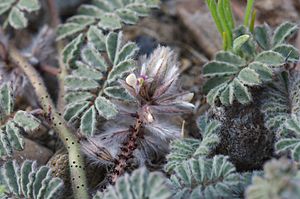Dalea mollissima facts for kids
Quick facts for kids Dalea mollissima |
|
|---|---|
 |
|
| Scientific classification | |
| Kingdom: | |
| (unranked): | |
| (unranked): | |
| (unranked): | |
| Order: | |
| Family: | |
| Genus: |
Dalea
|
| Species: |
D. mollissima
|
| Binomial name | |
| Dalea mollissima (Rydb.) Munz
|
|
Dalea mollissima is a beautiful wildflower that grows in the desert. It belongs to the legume family, just like peas and beans! People often call it by other names, like soft prairie clover, downy dalea, or silk dalea. This plant is known for its soft, fuzzy leaves and pretty flowers.
Where This Plant Lives
This special desert plant is native to some of North America's most famous deserts. You can find Dalea mollissima growing in the Mojave Desert and the Sonoran Desert. It also lives in the dry, brushy areas of nearby mountains, called chaparral.
You can spot this plant in several places. It grows in California, especially in the desert parts. You might also find it in northeastern Baja California (which is in Mexico), western Arizona, and southern Nevada. It likes to grow on flat desert ground and in dry riverbeds called washes. It usually lives in areas that are less than 900 meters (about 2,950 feet) above sea level.
What It Looks Like
Dalea mollissima is a small plant that often grows close to the ground. It can be an annual, meaning it lives for only one year. Or it can be a perennial, which means it comes back year after year. It forms a low, spreading mat on the desert floor.
Its leaves are quite interesting. Each leaf is made up of several pairs of small, oval-shaped leaflets. These leaflets are covered in soft, fine fuzz. This fuzz gives the plant its "soft" or "downy" names. The leaves look a bit like those of another plant called Dalea mollis. But Dalea mollissima has even thinner, softer hairs on its leaves.
When it blooms, Dalea mollissima produces fluffy groups of flowers. These flowers look a lot like tiny peas. They can be white or a soft lavender color. You can usually see these pretty flowers blooming from March to May. After the flowers, the plant produces a small fruit. This fruit is a legume pod, and it holds just one seed inside.

